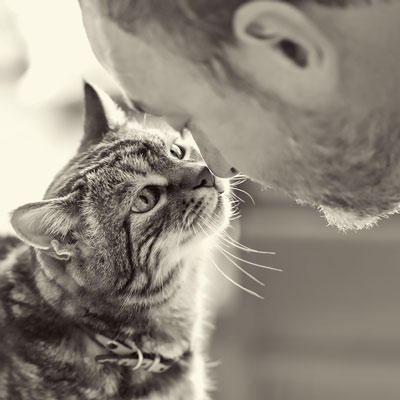Kidney Disease in Cats

Kidney disease (also called renal disease or renal insufficiency) is an extremely common diagnosis made in cats. Older cats, especially, develop kidney disease, but it can be found at any age.
Kidney disease is sometimes called kidney failure, though there are degrees that range from mild to severe.
What Do the Kidneys Do?
The kidneys are a pair of organs that are part of the urinary system. They are made up of nephrons, which process chemicals to separate those the body needs to keep from those that need to be discarded. The ones to be discarded are mixed with water and sent from the kidneys to the bladder, to be removed from the body as urine.
It's also the kidneys' job to keep hydration levels normal in the body. So, if a cat is dehydrated, the kidneys conserve water by concentrating the urine. That means that the waste materials must be mixed with less water before being removed from the body.
What Is Kidney Disease?
Kidney disease occurs when the kidneys lose their ability to properly separate needed from unneeded chemicals in the body efficiently. It may happen because of decrease blood flow to the kidneys or because too many nephrons are destroyed, leaving too few to do the job well.
When this occurs, toxins begin to build up in the cat's blood stream, and these interfere with various other bodily functions and make the cat feel sick.
Signs of Kidney Disease in Cats
Often, the first thing that happens when the kidneys begin to fail is that the cat drinks excessive amounts of water. This happens because the kidneys have lost their ability to concentrate the urine efficiently, so they keep "asking" for more water to do their job. Increased water consumption and urination, including inappropriate urination, are extremely important signs of early kidney disease in cats to be aware of and have checked out by the veterinarian.
Other signs of feline kidney (renal) disease include:
- Decreased appetite
- Increased vomiting
- Weight loss
- Lethargy or "slowing down"
Causes of Feline Kidney Disease
Kidneys can fail acutely, or suddenly, or chronically over a long period of time. Acute kidney failure is usually caused by a toxin, infection, or trauma. Chronic kidney failure may be the result of age or other disease processes that affect the kidneys.
Diagnosis of Feline Renal Disease
Diagnosis of kidney disease in cats requires a complete physical examination by a veterinarian. The doctor will also run blood tests and a urinalysis. Below are some of the common tests and the results that may be seen with feline kidney disease:
- Elevated creatinine and BUN levels. These substances are by-products of the kidneys' work breaking down proteins and removing excess from the body. As the kidneys lose their function, these levels begin to build up in the bloodstream. Creatinine is more sensitive to kidney function than BUN.
-
Dilute urine. As the kidneys lose their ability to concentrate urine properly, a urinalysis will show a consistently dilute urine.
- Increased phosphorus levels. Phosphorus levels in the blood that are higher than normal are an indication that the kidneys aren't functioning properly. Phosphorus levels also correlate to clinical signs in the cat. In other words, as the phosphorus level increases, the cat feels worse.
- Decreased potassium levels. The kidneys lose the ability to conserve potassium as they fail, resulting in low potassium levels in the blood. This can lead to muscle weakness and negatively affect heart function.
- Low red blood cell counts. Anemia, or decreased red blood cell numbers, occurs during kidney disease because it hampers the kidneys' ability to produce erythropoietin, which triggers the bone marrow to make more red blood cells.
- Elevated blood pressure. Healthy kidneys help regulate blood pressure, and kidney disease can result in high blood pressure which, in turn, can further damage the kidneys. It can also cause eye damage and other health problems.
Staging of Kidney Disease in Cats
Cats' kidney disease can be staged based on their blood creatinine levels. Levels between 1.6 and 2.8 mg/dL indicate Stage II, or mild failure. Levels between 2.8 and 5 mg/dL indicate Stage III or moderate failure, and levels over 5 mg/dL put the cat in Stage IV or severe failure.
There is also a fairly new test called SDMA, offered by IDEXX labs, which can indicate the presence of kidney disease even before creatinine levels are high. A high SDMA level can prompt further diagnostics and increased monitoring of a cat, so kidney failure can be slowed down as much as possible. This test is often done yearly, as a routine to catch a problem early.
Treatment of Feline Renal Disease
Treatment of your cat's kidney disease will depend on her individual circumstances and test results. Here are some things your veterinarian may wish to do with your cat:
- Hospitalization for intravenous fluids may be required if your cat is sick enough to be refusing to eat.
- Subcutaneous fluids may be required routinely to help keep your cat hydrated. You can usually do this at home. Learn more here: "Subcutaneous Fluid Therapy: Giving Your Cat Fluids at Home."
- Your veterinarian may recommend a pet water fountain to encourage your cat to take in more water.
- A prescription diet may be recommended. These are usually low in salt and protein, to make them easier for your cat's kidneys to handle.
- Antibiotics may be necessary if infection is suspected as the cause of the kidney disease.
- Blood pressure medications are required if the cat is hypertensive.
- Potassium supplements may be prescribed if blood work shows a low potassium level.
- Phosphorus binding agents are used to help lower the phosphorus levels in cats with high blood values.
- Medications to control nausea may be used if the veterinarian suspects it could be causing a cat to refuse food.
- Appetite stimulant medications are used in some cats with kidney failure.
- Erythropoietin injections along with iron supplements are available to help treat the anemia of kidney disease. Some cats' bodies reject the injections, and those cats may require blood transfusions.
- Kidney transplants are available for some cats at specialty veterinary clinics.
Prognosis for Renal Failure in Cats
Kidney disease in cats can't be reversed, but it can often be managed for long periods of time. The prognosis varies widely based on the cause of the condition, how aggressively treatment is pursued, and how well the cat handles the treatment.
You May Also Like These Articles:
Polycystic Kidney Disease (PKD) in Cats
Easter Lilies: A Holiday Hazard for Cats
Should Cats Get Tap or Filtered Water?
Dehydration in Cats: How Can You Tell If a Cat Is Dehydrated?
Foods Toxic to Cats - Slideshow
Notice: Ask-a-Vet is an affiliated service for those who wish to speak with a veterinary professional about their pet's specific condition. Initially, a bot will ask questions to determine the general nature of your concern. Then, you will be transferred to a human. There is a charge for the service if you choose to connect to a veterinarian. Ask-a-Vet is not manned by the staff or owners of CatHealth.com, and the advice given should not delay or replace a visit to your veterinarian.






